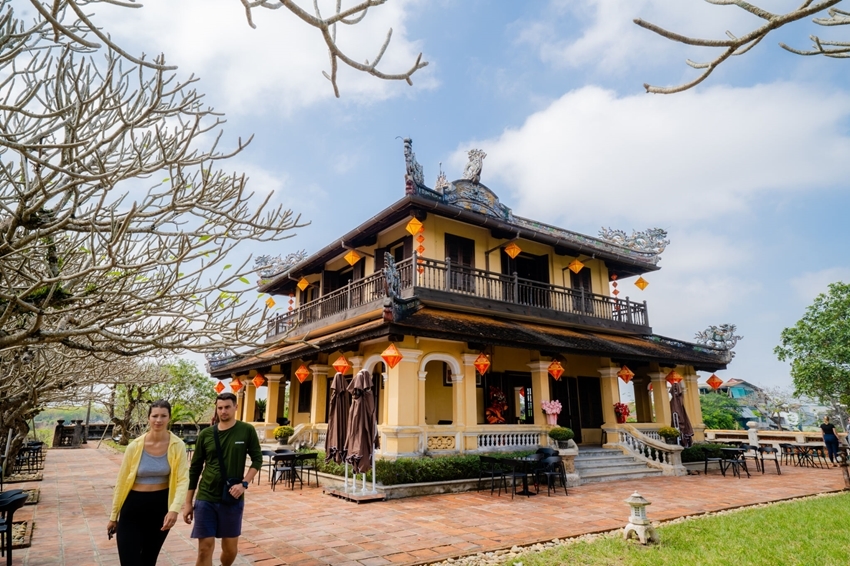 |
| The Tu Phuong Vo Su Pavilion, a cultural destination of the heritage of Hue Ancient Capital is reopening to visitors. (Photo: Bao Minh) |
The Tu Phuong Vo Su Pavilion (meaning safe and sound everywhere), which was built in 1923 during the reign of Emperor Khai Dinh (1916 - 1925). This was the building that the emperor built to prepare for his "Tu tuan dai khanh tiet" celebration (the 40th birthday celebration). The pavilion was built on the site of a communal house named “Tu Thong”, which had been built in 1804 under the reign of Emperor Gia Long (1802 - 1820), with the function of being a guard post for the army on duty to protect the Imperial City. After being built, the Tu Phuong Vo Su Pavilion became a place for the king and the royal family to enjoy fresh air and the scenery, as well as a place for princes and princesses to play and study daily in the late Nguyen Dynasty.
Located on the Bac Khuyet Dai, by the Hoa Binh Gate, the Tu Phuong Vo Su Pavilion, is a 2-storey building, which was built in a colonial architectural style, combining Asia and Europe styles, on an area of 182 square meters. As a rare building of the Royal Palace facing North, the Tu Phuong Vo Su Pavilion creates an architectural complex that represents the desire to bring peace to the dynasty, as the name given by Emperor Khai Dinh.
 |
| Visitors experiencing royal games at the Tu Phuong Vo Su Pavilion (Photo: Bao Minh) |
Through many ups and downs, the majority part of the Tu Phuong Vo Su Pavilion was destroyed, but the restoration project implemented in the period of 2008 - 2010 has returned to Hue an architectural building carrying a lot of historical significance.
Standing on the second floor of the Tu Phuong Vo Su Pavilion, visitors can have a panoramic view of the entire North side of the Imperial City, and observing the peaceful life of the people in the citadel area. Turning back, visitors could enjoy the wonderful views of the water, green trees and undulating architectural buildings in the Royal Palace. This is also the most beautiful viewing spot of Hue Imperial City. Legend has it that in the past, while standing in this position, Emperor Thieu Tri admired his entire Imperial Palace and was inspired to create a series of poems "Cung trung thap canh" (meaning the ten scenes in the palace). This series of poems was illustrated with paintings, and engraved with each poem on woodblocks by the Cabinet, and then sent to China to be painted on mirror paintings... Until this day, Hue still retains a part of this priceless set of paintings.
According to Mr. Hoang Viet Trung, Director of Hue Monuments Conservation Center, the cultural space of Tu Phuong Vo Su Pavilion being put into operation will help diversify types of tourism services in Hue Ancient Capital relic complex, contributing to promoting unique beauty of the Ancient Capital. At the same time, this place also arouses the passion and spirit of preserving and promoting the royal cultural heritage values of the people of Hue, creating deep impression for domestic and international visitors when coming to this land.
Now, you can visit the Tu Phuong Vo Su Pavilion Space, sip a cup of tea, enjoy the peaceful space, and admire the panoramic view on all four sides, so as to find the lightness and desire for peace and quiet in the midst of busy life.